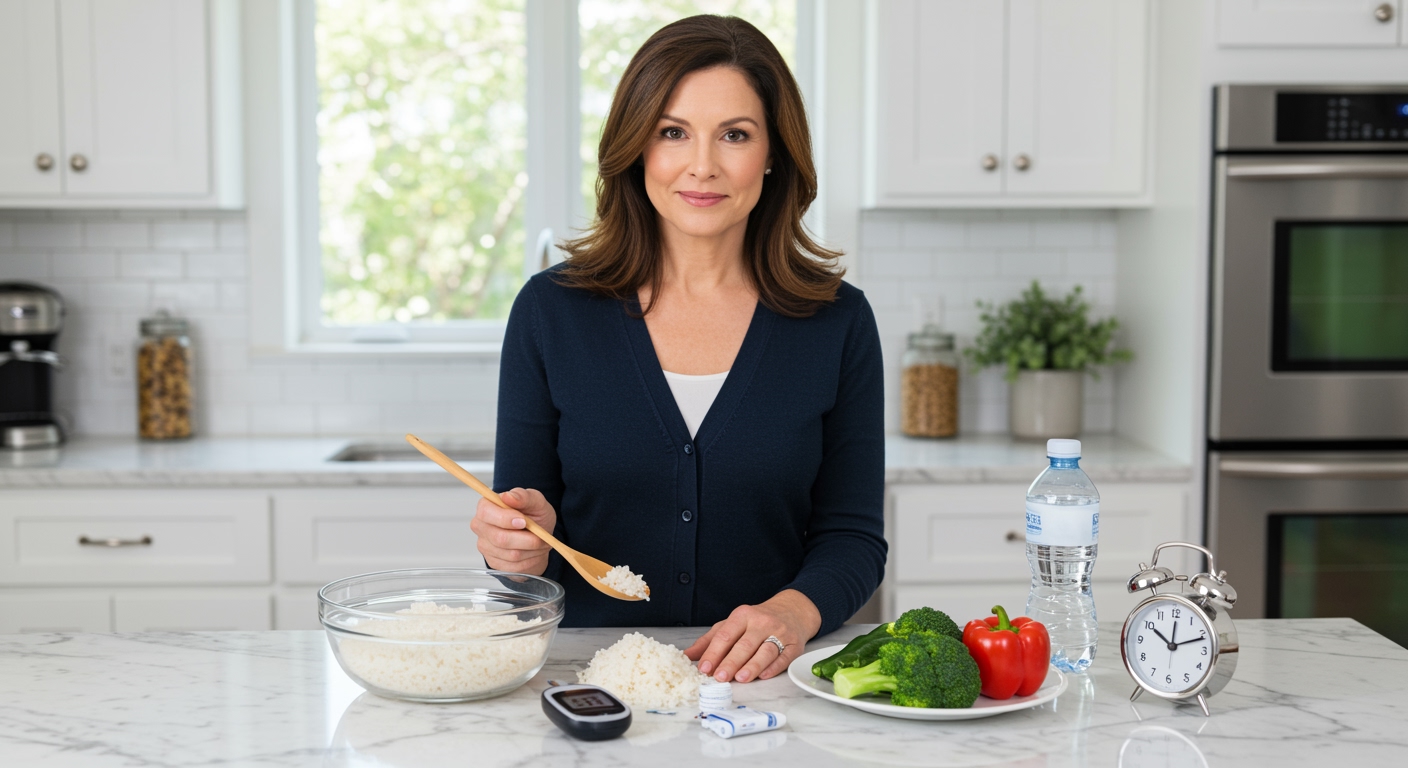✪ Key Takeaway: White rice can be part of a diabetic diet when eaten in controlled portions with fiber and protein.
Introduction
Your doctor just told you that you have diabetes, and suddenly everyone is warning you about white rice.
You might be wondering if you need to give up this staple food forever or if there is a way to still enjoy it safely.
Hi, I am Abdur, your nutrition coach, and today I am going to explain the real relationship between white rice and diabetes so you can make informed decisions about your diet.
What Makes White Rice Different From Other Carbs?
White rice has a high glycemic index of around 73, which means it raises blood sugar quickly after eating.
The refining process removes the bran and germ layers, leaving mostly starch behind.
This processing eliminates most of the fiber content that would normally slow down sugar absorption.
When you eat white rice, your digestive system breaks it down into glucose very efficiently.
Your pancreas then releases insulin to help cells absorb this glucose from your bloodstream.
For people with diabetes, this rapid glucose spike can be challenging because their bodies struggle to produce enough insulin or use it effectively.
However, the portion size and what you eat with white rice makes a huge difference in how it affects your blood sugar.
✪ Fact: One cup of cooked white rice contains about 45 grams of carbohydrates, equivalent to three slices of bread.
How Much White Rice Can Diabetics Actually Eat?
The key to eating white rice with diabetes is portion control and timing.
Most diabetes experts recommend limiting white rice to one-third cup of cooked rice per meal.
This portion contains approximately 15 grams of carbohydrates, which fits into most diabetic meal plans.
Your individual carbohydrate tolerance may vary based on your medication, activity level, and overall health status.
Some people with well-controlled diabetes can handle slightly larger portions, while others need to be more restrictive.
The best approach is to monitor your blood sugar levels before and after eating white rice to understand your personal response.
Testing your blood glucose 2 hours after eating will show you how different portion sizes affect your blood sugar control.
✪ Pro Tip: Use a measuring cup initially to train your eye to recognize proper portion sizes without constant measuring.
What Should You Eat With White Rice To Control Blood Sugar?
Pairing white rice with the right foods can significantly slow down its impact on blood sugar.
Protein sources like chicken, fish, tofu, or legumes help stabilize blood glucose levels when eaten with rice.
Adding fiber-rich vegetables such as broccoli, spinach, or bell peppers creates a more balanced meal.
Healthy fats from sources like avocado, nuts, or olive oil also help moderate glucose absorption.
The fiber and protein work together to slow down digestion, preventing the rapid blood sugar spikes that white rice can cause alone.
This combination approach allows you to enjoy white rice while maintaining better glycemic control throughout the day.
Always fill half your plate with non-starchy vegetables, one-quarter with lean protein, and limit the rice to the remaining quarter.
✪ Note: Eating protein before carbohydrates can reduce post-meal blood sugar spikes by up to 30 percent.
When Is The Best Time To Eat White Rice With Diabetes?
Meal timing plays a crucial role in how white rice affects your blood sugar levels.
Eating white rice earlier in the day, particularly at breakfast or lunch, gives your body more time to process the carbohydrates.
Your body typically has better insulin sensitivity in the morning, making it easier to handle carbohydrate-rich foods.
Avoiding white rice late in the evening helps prevent overnight blood sugar elevation when your metabolism naturally slows down.
If you exercise regularly, eating white rice before physical activity can help your muscles use the glucose more effectively.
Post-workout meals with white rice can also help replenish muscle glycogen without causing excessive blood sugar spikes.
The key is to align your rice consumption with your body’s natural metabolic rhythms and activity patterns.
✪ Fact: Your body burns carbohydrates 20 percent more efficiently in the morning compared to evening hours.
Are There Better Rice Alternatives For Diabetics?
While white rice can fit into a diabetic diet, several alternatives offer better blood sugar control.
Brown rice contains more fiber and has a lower glycemic index, causing slower blood sugar rises.
Wild rice provides even more protein and fiber while delivering a nuttier flavor and chewy texture.
Cauliflower rice offers a low-carb alternative with only 5 grams of carbs per cup compared to 45 grams in white rice.
Quinoa delivers complete protein along with fiber, making it an excellent grain substitute for blood sugar management.
You can also try mixing white rice with these alternatives to gradually transition your taste preferences.
The goal is finding sustainable options that you enjoy eating while supporting your diabetes management goals.
✪ Pro Tip: Start by replacing half your white rice with brown rice or cauliflower rice to ease the transition.
The Bottom Line
White rice does not have to be completely eliminated from your diet if you have diabetes, but it requires careful management and moderation.
Smart eating is about making informed choices, not perfect restrictions, and understanding how foods affect your individual blood sugar response empowers you to make better decisions.
I would love to hear about your experiences with white rice and diabetes management, so please share your questions, success stories, or challenges in the comments below.
References
At NutritionCrown, we use quality and credible sources to ensure our content is accurate and trustworthy. Below are the sources referenced in creating this article:
- PubMed: White rice consumption and risk of type 2 diabetes
- Harvard School of Public Health: Eating white rice regularly may raise type 2 diabetes risk
- PMC: White rice, brown rice, and risk of type 2 diabetes
- Healthline: Diabetes and Rice: What to Know





